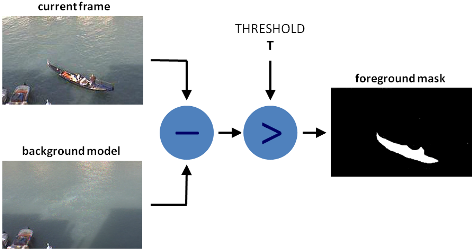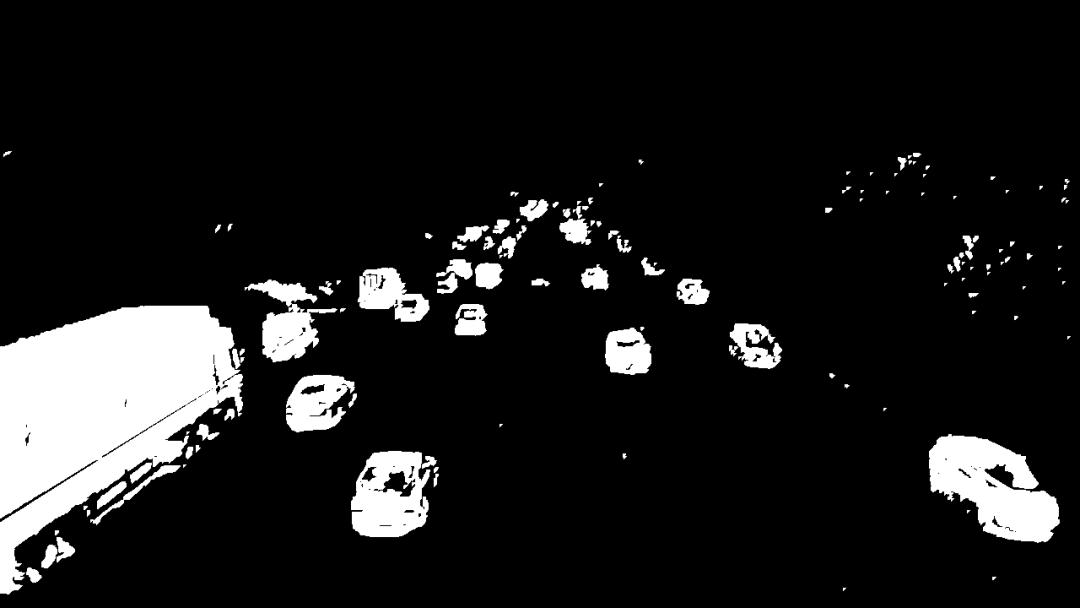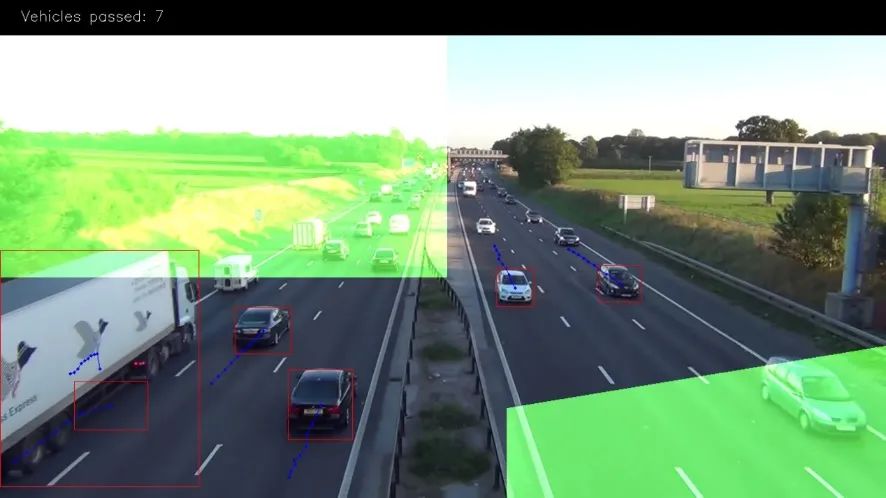今天,我們將一起探討如何基于計算機視覺實現道路交通計數。
在本教程中,我們將僅使用Python和OpenCV,并借助背景減除算法非常簡單地進行運動檢測。
我們將從以下四個方面進行介紹:
1. 用于物體檢測的背景減法算法主要思想。
2. OpenCV圖像過濾器。
3. 利用輪廓檢測物體。
4. 建立進一步數據處理的結構。
背景扣除算法

有許多不同的背景扣除算法,但是它們的主要思想都很簡單。
假設有一個房間的視頻,在某些幀上沒有人和寵物,那么此時的視頻基本為靜態的,我們將其稱為背景(background_layer)。因此要獲取在視頻上移動的對象,我們只需要:用當前幀減去背景即可。
由于光照變化,人為移動物體,或者始終存在移動的人和寵物,我們將無法獲得靜態幀。在這種情況下,我們從視頻中選出一些圖像幀,如果絕大多數圖像幀中都具有某個相同的像素點,則此將像素作為background_layer中的一部分。
我們將使用MOG算法進行背景扣除

原始幀
代碼如下所示:
import os import logging import logging.handlers import random import numpy as np import skvideo.io import cv2 import matplotlib.pyplot as plt import utils # without this some strange errors happen cv2.ocl.setUseOpenCL(False) random.seed(123) # ============================================================================ IMAGE_DIR = "./out" VIDEO_SOURCE = "input.mp4" SHAPE = (720, 1280) # HxW # ============================================================================ def train_bg_subtractor(inst, cap, num=500): ''' BG substractor need process some amount of frames to start giving result ''' print ('Training BG Subtractor...') i = 0 for frame in cap: inst.apply(frame, None, 0.001) i += 1 if i >= num: return cap def main(): log = logging.getLogger("main") # creting MOG bg subtractor with 500 frames in cache # and shadow detction bg_subtractor = cv2.createBackgroundSubtractorMOG2( history=500, detectShadows=True) # Set up image source # You can use also CV2, for some reason it not working for me cap = skvideo.io.vreader(VIDEO_SOURCE) # skipping 500 frames to train bg subtractor train_bg_subtractor(bg_subtractor, cap, num=500) frame_number = -1 for frame in cap: if not frame.any(): log.error("Frame capture failed, stopping...") break frame_number += 1 utils.save_frame(frame, "./out/frame_%04d.png" % frame_number) fg_mask = bg_subtractor.apply(frame, None, 0.001) utils.save_frame(frame, "./out/fg_mask_%04d.png" % frame_number) # ============================================================================ if __name__ == "__main__": log = utils.init_logging() if not os.path.exists(IMAGE_DIR): log.debug("Creating image directory `%s`...", IMAGE_DIR) os.makedirs(IMAGE_DIR) main()
處理后得到下面的前景圖像

去除背景后的前景圖像
我們可以看出前景圖像上有一些噪音,可以通過標準濾波技術可以將其消除。
濾波
針對我們現在的情況,我們將需要以下濾波函數:Threshold、Erode、Dilate、Opening、Closing。
首先,我們使用“Closing”來移除區域中的間隙,然后使用“Opening”來移除個別獨立的像素點,然后使用“Dilate”進行擴張以使對象變粗。代碼如下:
def filter_mask(img): kernel = cv2.getStructuringElement(cv2.MORPH_ELLIPSE, (2, 2)) # Fill any small holes closing = cv2.morphologyEx(img, cv2.MORPH_CLOSE, kernel) # Remove noise opening = cv2.morphologyEx(closing, cv2.MORPH_OPEN, kernel) # Dilate to merge adjacent blobs dilation = cv2.dilate(opening, kernel, iterations=2) # threshold th = dilation[dilation < 240] = 0 return th
處理后的前景如下:

利用輪廓進行物體檢測
我們將使用cv2.findContours函數對輪廓進行檢測。我們在使用的時候可以選擇的參數為:
cv2.CV_RETR_EXTERNAL------僅獲取外部輪廓。
cv2.CV_CHAIN_APPROX_TC89_L1------使用Teh-Chin鏈逼近算法(更快)
代碼如下:
def get_centroid(x, y, w, h):
x1 = int(w / 2)
y1 = int(h / 2)
cx = x + x1
cy = y + y1
return (cx, cy)
def detect_vehicles(fg_mask, min_contour_width=35, min_contour_height=35):
matches = []
# finding external contours
im, contours, hierarchy = cv2.findContours(
fg_mask, cv2.RETR_EXTERNAL, cv2.CHAIN_APPROX_TC89_L1)
# filtering by with, height
for (i, contour) in enumerate(contours):
(x, y, w, h) = cv2.boundingRect(contour)
contour_valid = (w >= min_contour_width) and (
h >= min_contour_height)
if not contour_valid:
continue
# getting center of the bounding box
centroid = get_centroid(x, y, w, h)
matches.append(((x, y, w, h), centroid))
return matches
建立數據處理框架
我們都知道在ML和CV中,沒有一個算法可以處理所有問題。即使存在這種算法,我們也不會使用它,因為它很難大規模有效。例如幾年前Netflix公司用300萬美元的獎金懸賞最佳電影推薦算法。有一個團隊完成這個任務,但是他們的推薦算法無法大規模運行,因此其實對公司毫無用處。但是,Netflix公司仍獎勵了他們100萬美元。
接下來我們來建立解決當前問題的框架,這樣可以使數據的處理更加方便
class PipelineRunner(object):
'''
Very simple pipline.
Just run passed processors in order with passing context from one to
another.
You can also set log level for processors.
'''
def __init__(self, pipeline=None, log_level=logging.DEBUG):
self.pipeline = pipeline or []
self.context = {}
self.log = logging.getLogger(self.__class__.__name__)
self.log.setLevel(log_level)
self.log_level = log_level
self.set_log_level()
def set_context(self, data):
self.context = data
def add(self, processor):
if not isinstance(processor, PipelineProcessor):
raise Exception(
'Processor should be an isinstance of PipelineProcessor.')
processor.log.setLevel(self.log_level)
self.pipeline.append(processor)
def remove(self, name):
for i, p in enumerate(self.pipeline):
if p.__class__.__name__ == name:
del self.pipeline[i]
return True
return False
def set_log_level(self):
for p in self.pipeline:
p.log.setLevel(self.log_level)
def run(self):
for p in self.pipeline:
self.context = p(self.context)
self.log.debug("Frame #%d processed.", self.context['frame_number'])
return self.context
class PipelineProcessor(object):
'''
Base class for processors.
'''
def __init__(self):
self.log = logging.getLogger(self.__class__.__name__)
首先我們獲取一張處理器運行順序的列表,讓每個處理器完成一部分工作,在案順序完成執行以獲得最終結果。
我們首先創建輪廓檢測處理器。輪廓檢測處理器只需將前面的背景扣除,濾波和輪廓檢測部分合并在一起即可,代碼如下所示:
class ContourDetection(PipelineProcessor):
'''
Detecting moving objects.
Purpose of this processor is to subtrac background, get moving objects
and detect them with a cv2.findContours method, and then filter off-by
width and height.
bg_subtractor - background subtractor isinstance.
min_contour_width - min bounding rectangle width.
min_contour_height - min bounding rectangle height.
save_image - if True will save detected objects mask to file.
image_dir - where to save images(must exist).
'''
def __init__(self, bg_subtractor, min_contour_width=35, min_contour_height=35, save_image=False, image_dir='images'):
super(ContourDetection, self).__init__()
self.bg_subtractor = bg_subtractor
self.min_contour_width = min_contour_width
self.min_contour_height = min_contour_height
self.save_image = save_image
self.image_dir = image_dir
def filter_mask(self, img, a=None):
'''
This filters are hand-picked just based on visual tests
'''
kernel = cv2.getStructuringElement(cv2.MORPH_ELLIPSE, (2, 2))
# Fill any small holes
closing = cv2.morphologyEx(img, cv2.MORPH_CLOSE, kernel)
# Remove noise
opening = cv2.morphologyEx(closing, cv2.MORPH_OPEN, kernel)
# Dilate to merge adjacent blobs
dilation = cv2.dilate(opening, kernel, iterations=2)
return dilation
def detect_vehicles(self, fg_mask, context):
matches = []
# finding external contours
im2, contours, hierarchy = cv2.findContours(
fg_mask, cv2.RETR_EXTERNAL, cv2.CHAIN_APPROX_TC89_L1)
for (i, contour) in enumerate(contours):
(x, y, w, h) = cv2.boundingRect(contour)
contour_valid = (w >= self.min_contour_width) and (
h >= self.min_contour_height)
if not contour_valid:
continue
centroid = utils.get_centroid(x, y, w, h)
matches.append(((x, y, w, h), centroid))
return matches
def __call__(self, context):
frame = context['frame'].copy()
frame_number = context['frame_number']
fg_mask = self.bg_subtractor.apply(frame, None, 0.001)
# just thresholding values
fg_mask[fg_mask < 240] = 0
fg_mask = self.filter_mask(fg_mask, frame_number)
if self.save_image:
utils.save_frame(fg_mask, self.image_dir +
"/mask_%04d.png" % frame_number, flip=False)
context['objects'] = self.detect_vehicles(fg_mask, context)
context['fg_mask'] = fg_mask
return contex
現在,讓我們創建一個處理器,該處理器將找出不同的幀上檢測到的相同對象,創建路徑,并對到達出口區域的車輛進行計數。代碼如下所示:
'''
Counting vehicles that entered in exit zone.
Purpose of this class based on detected object and local cache create
objects pathes and count that entered in exit zone defined by exit masks.
exit_masks - list of the exit masks.
path_size - max number of points in a path.
max_dst - max distance between two points.
'''
def __init__(self, exit_masks=[], path_size=10, max_dst=30, x_weight=1.0, y_weight=1.0):
super(VehicleCounter, self).__init__()
self.exit_masks = exit_masks
self.vehicle_count = 0
self.path_size = path_size
self.pathes = []
self.max_dst = max_dst
self.x_weight = x_weight
self.y_weight = y_weight
def check_exit(self, point):
for exit_mask in self.exit_masks:
try:
if exit_mask[point[1]][point[0]] == 255:
return True
except:
return True
return False
def __call__(self, context):
objects = context['objects']
context['exit_masks'] = self.exit_masks
context['pathes'] = self.pathes
context['vehicle_count'] = self.vehicle_count
if not objects:
return context
points = np.array(objects)[:, 0:2]
points = points.tolist()
# add new points if pathes is empty
if not self.pathes:
for match in points:
self.pathes.append([match])
else:
# link new points with old pathes based on minimum distance between
# points
new_pathes = []
for path in self.pathes:
_min = 999999
_match = None
for p in points:
if len(path) == 1:
# distance from last point to current
d = utils.distance(p[0], path[-1][0])
else:
# based on 2 prev points predict next point and calculate
# distance from predicted next point to current
xn = 2 * path[-1][0][0] - path[-2][0][0]
yn = 2 * path[-1][0][1] - path[-2][0][1]
d = utils.distance(
p[0], (xn, yn),
x_weight=self.x_weight,
y_weight=self.y_weight
)
if d < _min:
_min = d
_match = p
if _match and _min <= self.max_dst:
points.remove(_match)
path.append(_match)
new_pathes.append(path)
# do not drop path if current frame has no matches
if _match is None:
new_pathes.append(path)
self.pathes = new_pathes
# add new pathes
if len(points):
for p in points:
# do not add points that already should be counted
if self.check_exit(p[1]):
continue
self.pathes.append([p])
# save only last N points in path
for i, _ in enumerate(self.pathes):
self.pathes[i] = self.pathes[i][self.path_size * -1:]
# count vehicles and drop counted pathes:
new_pathes = []
for i, path in enumerate(self.pathes):
d = path[-2:]
if (
# need at list two points to count
len(d) >= 2 and
# prev point not in exit zone
not self.check_exit(d[0][1]) and
# current point in exit zone
self.check_exit(d[1][1]) and
# path len is bigger then min
self.path_size <= len(path)
):
self.vehicle_count += 1
else:
# prevent linking with path that already in exit zone
add = True
for p in path:
if self.check_exit(p[1]):
add = False
break
if add:
new_pathes.append(path)
self.pathes = new_pathes
context['pathes'] = self.pathes
context['objects'] = objects
context['vehicle_count'] = self.vehicle_count
self.log.debug('#VEHICLES FOUND: %s' % self.vehicle_count)
return context
上面的代碼有點復雜,因此讓我們一個部分一個部分的介紹一下。

上面的圖像中綠色的部分是出口區域。我們在這里對車輛進行計數,只有當車輛移動的長度超過3個點我們才進行計算
我們使用掩碼來解決這個問題,因為它比使用矢量算法有效且簡單得多。只需使用“二進制和”即可選出車輛區域中點。設置方式如下:
EXIT_PTS = np.array([
[[732, 720], [732, 590], [1280, 500], [1280, 720]],
[[0, 400], [645, 400], [645, 0], [0, 0]]
])
base = np.zeros(SHAPE + (3,), dtype='uint8')
exit_mask = cv2.fillPoly(base, EXIT_PTS, (255, 255, 255))[:, :, 0]
現在我們將檢測到的點鏈接起來。
對于第一幀圖像,我們將所有點均添加為新路徑。
接下來,如果len(path)== 1,我們在新檢測到的對象中找到與每條路徑最后一點距離最近的對象。
如果len(path)> 1,則使用路徑中的最后兩個點,即在同一條線上預測新點,并找到該點與當前點之間的最小距離。
具有最小距離的點將添加到當前路徑的末端并從列表中刪除。如果在此之后還剩下一些點,我們會將其添加為新路徑。這個過程中我們還會限制路徑中的點數。
new_pathes = []
for path in self.pathes:
_min = 999999
_match = None
for p in points:
if len(path) == 1:
# distance from last point to current
d = utils.distance(p[0], path[-1][0])
else:
# based on 2 prev points predict next point and calculate
# distance from predicted next point to current
xn = 2 * path[-1][0][0] - path[-2][0][0]
yn = 2 * path[-1][0][1] - path[-2][0][1]
d = utils.distance(
p[0], (xn, yn),
x_weight=self.x_weight,
y_weight=self.y_weight
)
if d < _min:
_min = d
_match = p
if _match and _min <= self.max_dst:
points.remove(_match)
path.append(_match)
new_pathes.append(path)
# do not drop path if current frame has no matches
if _match is None:
new_pathes.append(path)
self.pathes = new_pathes
# add new pathes
if len(points):
for p in points:
# do not add points that already should be counted
if self.check_exit(p[1]):
continue
self.pathes.append([p])
# save only last N points in path
for i, _ in enumerate(self.pathes):
self.pathes[i] = self.pathes[i][self.path_size * -1:]
現在,我們將嘗試計算進入出口區域的車輛。為此,我們需獲取路徑中的最后2個點,并檢查len(path)是否應大于限制。
# count vehicles and drop counted pathes:
new_pathes = []
for i, path in enumerate(self.pathes):
d = path[-2:]
if (
# need at list two points to count
len(d) >= 2 and
# prev point not in exit zone
not self.check_exit(d[0][1]) and
# current point in exit zone
self.check_exit(d[1][1]) and
# path len is bigger then min
self.path_size <= len(path)
):
self.vehicle_count += 1
else:
# prevent linking with path that already in exit zone
add = True
for p in path:
if self.check_exit(p[1]):
add = False
break
if add:
new_pathes.append(path)
self.pathes = new_pathes
context['pathes'] = self.pathes
context['objects'] = objects
context['vehicle_count'] = self.vehicle_count
self.log.debug('#VEHICLES FOUND: %s' % self.vehicle_count)
return context
最后兩個處理器是CSV編寫器,用于創建報告CSV文件,以及用于調試和精美圖片的可視化。
class CsvWriter(PipelineProcessor):
def __init__(self, path, name, start_time=0, fps=15):
super(CsvWriter, self).__init__()
self.fp = open(os.path.join(path, name), 'w')
self.writer = csv.DictWriter(self.fp, fieldnames=['time', 'vehicles'])
self.writer.writeheader()
self.start_time = start_time
self.fps = fps
self.path = path
self.name = name
self.prev = None
def __call__(self, context):
frame_number = context['frame_number']
count = _count = context['vehicle_count']
if self.prev:
_count = count - self.prev
time = ((self.start_time + int(frame_number / self.fps)) * 100
+ int(100.0 / self.fps) * (frame_number % self.fps))
self.writer.writerow({'time': time, 'vehicles': _count})
self.prev = count
return context
class Visualizer(PipelineProcessor):
def __init__(self, save_image=True, image_dir='images'):
super(Visualizer, self).__init__()
self.save_image = save_image
self.image_dir = image_dir
def check_exit(self, point, exit_masks=[]):
for exit_mask in exit_masks:
if exit_mask[point[1]][point[0]] == 255:
return True
return False
def draw_pathes(self, img, pathes):
if not img.any():
return
for i, path in enumerate(pathes):
path = np.array(path)[:, 1].tolist()
for point in path:
cv2.circle(img, point, 2, CAR_COLOURS[0], -1)
cv2.polylines(img, [np.int32(path)], False, CAR_COLOURS[0], 1)
return img
def draw_boxes(self, img, pathes, exit_masks=[]):
for (i, match) in enumerate(pathes):
contour, centroid = match[-1][:2]
if self.check_exit(centroid, exit_masks):
continue
x, y, w, h = contour
cv2.rectangle(img, (x, y), (x + w - 1, y + h - 1),
BOUNDING_BOX_COLOUR, 1)
cv2.circle(img, centroid, 2, CENTROID_COLOUR, -1)
return img
def draw_ui(self, img, vehicle_count, exit_masks=[]):
# this just add green mask with opacity to the image
for exit_mask in exit_masks:
_img = np.zeros(img.shape, img.dtype)
_img[:, :] = EXIT_COLOR
mask = cv2.bitwise_and(_img, _img, mask=exit_mask)
cv2.addWeighted(mask, 1, img, 1, 0, img)
# drawing top block with counts
cv2.rectangle(img, (0, 0), (img.shape[1], 50), (0, 0, 0), cv2.FILLED)
cv2.putText(img, ("Vehicles passed: {total} ".format(total=vehicle_count)), (30, 30),
cv2.FONT_HERSHEY_SIMPLEX, 0.7, (255, 255, 255), 1)
return img
def __call__(self, context):
frame = context['frame'].copy()
frame_number = context['frame_number']
pathes = context['pathes']
exit_masks = context['exit_masks']
vehicle_count = context['vehicle_count']
frame = self.draw_ui(frame, vehicle_count, exit_masks)
frame = self.draw_pathes(frame, pathes)
frame = self.draw_boxes(frame, pathes, exit_masks)
utils.save_frame(frame, self.image_dir +
"/processed_%04d.png" % frame_number)
return context
結論
正如我們看到的那樣,它并不像許多人想象的那么難。但是,如果小伙伴運行腳本,小伙伴會發現此解決方案并不理想,存在前景對象存在重疊的問題,并且它也沒有按類型對車輛進行分類。但是,當相機有較好位置,例如位于道路正上方時,該算法具有很好的準確性。
責任編輯:彭菁
-
過濾器
+關注
關注
1文章
432瀏覽量
19685 -
計算機視覺
+關注
關注
8文章
1700瀏覽量
46077 -
OpenCV
+關注
關注
31文章
635瀏覽量
41463
原文標題:使用OpenCV實現道路車輛計數
文章出處:【微信號:vision263com,微信公眾號:新機器視覺】歡迎添加關注!文章轉載請注明出處。
發布評論請先 登錄
相關推薦
關于基于英特爾AI計算機視覺的邊緣計算設備





 如何基于計算機視覺實現道路交通計數
如何基于計算機視覺實現道路交通計數













評論